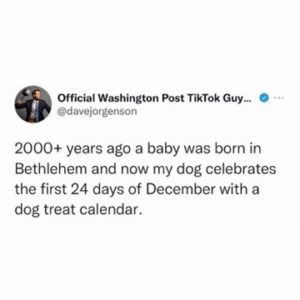A tradition that started as the hanging of devotional imagery each day leading up to Christmas has evolved into brands creating custom product calendars full of daily gifts. Consumer interest has increased +92% since the 2020 holiday season, and our CultureTap team anticipates brand advent calendars will continue to trend during the 2023 holiday season.

Here are some key learnings to consider when planning your brand’s future advent calendar…
Get in the Holiday spirit EARLY!
Consumer searches for advent calendars start as early as September but tends to ramp up each year as Halloween ends. Google, Pinterest and TikTok search queries for Advent calendars see a +25% increase from October 31st to November 6th year over year. Search queries increase by an additional +30% during the week of Thanksgiving but quickly decline after December 5th.
It’s important to make sure consumers are aware of your upcoming advent calendar. Brands like Cult Beauty and Thames & Kosmos announced their 2022 Advent calendars in August and brands like ASOS , Beauty Pie, Williams Sonoma, Dermstore, Godiva, Life Extension and more quickly followed with September announcements. Early announcements earned up to 60% higher engagement rates than the average post in 2022… which highlights consumer excitement and genuine interest.
Count on Your Calendar Getting Reviewed on Social Media
Mentions on social platforms like Instagram and TikTok increased over 40% from 2020 to 2021 and are seeing continued growth from 2021 to 2022. With over 4B Advent calendar video views on TikTok, it’s clear that consumers love to share these purchases on social. Not only do consumers love to share their “unboxing” style videos, they like to watch and engage with the videos. In the past 30 days alone there have been 60K videos about advent calendars shared on TikTok—the topic is currently at 97% peak viewership.
While consumers might love the calendars, they don’t love when the bang isn’t worth their buck. Brands who plan to create them should learn from the mistakes of brands who received not-so-positive feedback. Last year luxury brand Chanel received backlash on their $825 calendar. Consumers called out the sample product sizes. Reviews plummeted when items like a small snow globe and branded stickers were revealed. The people of TikTok were quick to point out that the true value of the calendar was around $250. After receiving the high-volume of negative reviews, the brand removed themselves from the TikTok platform. [Read more in this article by Slate.com.]
In 2022, luxury brand Dior released two advent calendars. The brand marketed their high-priced calendars as “exceptional,” and similar to Chanel in 2021, it didn’t take long for consumers to disagree with this claim.
The brand’s beauty Advent calendar sold for $650. It was filled with fragrances, makeup, skin care products, and signature sent candles. While consumers did give the brand props for the variety of the contents, most reviews were from frustrated customers who claim all the products were “freebies” that Dior customers typically get with a standard purchase. Many videos shared on TikTok are full of negative sentiment, sharing disappointment (example here).
While the reviews of the beauty calendar were less than satisfactory, Dior’s $3,500 “home” advent calendar racked up even worse reviews. Influencer Jackie Aina purchased the high-priced calendar and shared her unboxing experience with her 1.8M followers on TikTok. Jackie posted multiple videos revealing the contents, with her most engaged with video earning over 3.2M views and nearly 450K engagements. While engagement rates were high, the comment section was primarily negative, with consumers calling out Dior for being “cheap” and “stingy” with this high-priced, “luxury” calendar. This video featured Day 6 of the calendar, which revealed the lid to the candle from Day 4. If a consumer were to purchase a candle directly from Dior, the candle and lid would come together… separating them outraged consumers. The most liked comment on the video was “Not the lid coming on its own day 💀💀🤣”, which received over 67K likes. Not only did the brand get flooded with negative reviews on TikTok, the video became so big that the NY Post shared an article about the outrage in the beauty and fashion communities.
Chanel and Dior are not the only brands that have been dinged for their advent calendars, many brands in 2022 were criticized for similar reasons. If your brand plans to create a calendar, remember:
- Make sure the sticker value is less than or equal to the contents inside… consumers WILL do their research and share their thoughts on social.
- Include a variety of products within the calendar. Many brands this year were roasted for having the same product featured in multiple days, which consumers claimed was boring and “stingy”.
Thinking Outside the Advent Calendar Box
What if your brand doesn’t have tangible items to fill an advent calendar? It’s time to get creative. Here are brands who found unique ways to engage with the advent calendar trend in 2022…
- HBO Max released their countdown to Christmas Advent calendar that housed 24 “surprise” holiday inspired movies for each day leading up to the holiday.
- DIY Brand, Rust-Oleum, inspired their customers by promoting a “DIY Beer Advent calendar”.
- Americas Test Kitchen, a popular series on PBS, released an Instagram-based advent calendar that shared kitchen hacks and tips with their fans. In this video the brand teaches followers how to soften brown sugar after it hardens.
- Smoothie King promoted their app by creating a 25 days of discounts via a digital, app-based Advent calendar.
The Countdown Is On
Let’s learn all we can from 2022 because the countdown to Advent 2023 starts now. Your brand’s marketing can tap into the cultural moment to make your calendar a true delight to your customers – and your revenue goals. And if you want an extra advent advantage, call us. CultureTap will be there with (jingle) bells on.












